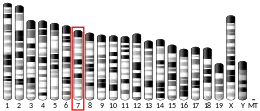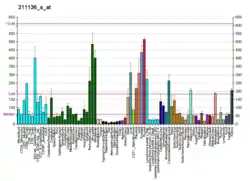Cleft lip and palate transmembrane protein 1
Cleft lip and palate transmembrane protein 1 (Clptm1) is a multi-transmembrane protein that in humans is encoded by the CLPTM1 gene.[4][5] Clptm1 was characterized in 1995 as a surface membrane protein in the thymus during embryonic development in mice and is suggested to have an important role in T-cell development.[6][7] A more recent study shows a role in GABAA receptor subunit intracellular anchoring and regulation resulting in an influence on synaptic strength[8] Clptm1 belongs to a family of several eukaryotic cleft lip and palate transmembrane protein 1 sequences.
| CLPTM1 | |||||||||||||||||||||||||||||||||||||||||||||||||||
|---|---|---|---|---|---|---|---|---|---|---|---|---|---|---|---|---|---|---|---|---|---|---|---|---|---|---|---|---|---|---|---|---|---|---|---|---|---|---|---|---|---|---|---|---|---|---|---|---|---|---|---|
| Identifiers | |||||||||||||||||||||||||||||||||||||||||||||||||||
| Aliases | CLPTM1, transmembrane protein, CLPTM1 regulator of GABA type A receptor forward trafficking | ||||||||||||||||||||||||||||||||||||||||||||||||||
| External IDs | OMIM: 604783 MGI: 1927155 HomoloGene: 37464 GeneCards: CLPTM1 | ||||||||||||||||||||||||||||||||||||||||||||||||||
| |||||||||||||||||||||||||||||||||||||||||||||||||||
| |||||||||||||||||||||||||||||||||||||||||||||||||||
| |||||||||||||||||||||||||||||||||||||||||||||||||||
| |||||||||||||||||||||||||||||||||||||||||||||||||||
| Wikidata | |||||||||||||||||||||||||||||||||||||||||||||||||||
| |||||||||||||||||||||||||||||||||||||||||||||||||||
| Cleft lip and palate transmembrane 1 | |||||||||
|---|---|---|---|---|---|---|---|---|---|
| Identifiers | |||||||||
| Symbol | CLPTM1 | ||||||||
| Pfam | PF05602 | ||||||||
| InterPro | IPR008429 | ||||||||
| |||||||||
Cleft lip with or without cleft palate is a common birth defect that is genetically complex. The non-syndromic forms have been studied genetically using linkage and candidate-gene association studies with only partial success in defining the loci responsible for orofacial clefting. CLPTM1 encodes a transmembrane protein and has strong homology to two Caenorhabditis elegans genes, suggesting that CLPTM1 may belong to a new gene family.[9] This family also contains the Homo sapiens cisplatin resistance related protein CRR9p which is associated with CDDP-induced apoptosis.[10]
References
- GRCm38: Ensembl release 89: ENSMUSG00000002981 - Ensembl, May 2017
- "Human PubMed Reference:". National Center for Biotechnology Information, U.S. National Library of Medicine.
- "Mouse PubMed Reference:". National Center for Biotechnology Information, U.S. National Library of Medicine.
- Yoshiura K, Machida J, Daack-Hirsch S, Patil SR, Ashworth LK, Hecht JT, Murray JC (December 1998). "Characterization of a novel gene disrupted by a balanced chromosomal translocation t(2;19)(q11.2;q13.3) in a family with cleft lip and palate". Genomics. 54 (2): 231–240. doi:10.1006/geno.1998.5577. PMID 9828125.
- "Entrez Gene: CLPTM1 cleft lip and palate associated transmembrane protein 1".
- Takeuchi T, Kuro-o M, Miyazawa H, Ohtsuki Y, Yamamoto H (July 1997). "Transgenic expression of a novel thymic epithelial cell antigen stimulates aberrant development of thymocytes". Journal of Immunology. 159 (2): 726–733. PMID 9218588.
- Takeuchi T, Tamamoto T, Tamura H, Yamamoto H (April 1995). "Characterization of a 50 kDa surface membrane protein on thymic stromal cells as an important factor for early T cell development". International Immunology. 7 (4): 583–590. doi:10.1093/intimm/7.4.583. PMID 7547685.
- Ge Y, Kang Y, Cassidy RM, Moon KM, Lewis R, Wong RO, et al. (February 2018). "Clptm1 Limits Forward Trafficking of GABAA Receptors to Scale Inhibitory Synaptic Strength". Neuron. 97 (3): 596–610.e8. doi:10.1016/j.neuron.2017.12.038. PMC 5810584. PMID 29395912.
- Yoshiura K, Machida J, Daack-Hirsch S, Patil SR, Ashworth LK, Hecht JT, Murray JC (December 1998). "Characterization of a novel gene disrupted by a balanced chromosomal translocation t(2;19)(q11.2;q13.3) in a family with cleft lip and palate". Genomics. 54 (2): 231–240. doi:10.1006/geno.1998.5577. PMID 9828125.
- Yamamoto K, Okamoto A, Isonishi S, Ochiai K, Ohtake Y (February 2001). "A novel gene, CRR9, which was up-regulated in CDDP-resistant ovarian tumor cell line, was associated with apoptosis". Biochemical and Biophysical Research Communications. 280 (4): 1148–1154. doi:10.1006/bbrc.2001.4250. PMID 11162647.
Further reading
- Maruyama K, Sugano S (January 1994). "Oligo-capping: a simple method to replace the cap structure of eukaryotic mRNAs with oligoribonucleotides". Gene. 138 (1–2): 171–174. doi:10.1016/0378-1119(94)90802-8. PMID 8125298.
- Takeuchi T, Kuro-o M, Miyazawa H, Ohtsuki Y, Yamamoto H (July 1997). "Transgenic expression of a novel thymic epithelial cell antigen stimulates abberant development of thymocytes". Journal of Immunology. 159 (2): 726–733. PMID 9218588.
- Suzuki Y, Yoshitomo-Nakagawa K, Maruyama K, Suyama A, Sugano S (October 1997). "Construction and characterization of a full length-enriched and a 5'-end-enriched cDNA library". Gene. 200 (1–2): 149–156. doi:10.1016/S0378-1119(97)00411-3. PMID 9373149.
- Rossi MR, Hawthorn L, Platt J, Burkhardt T, Cowell JK, Ionov Y (September 2005). "Identification of inactivating mutations in the JAK1, SYNJ2, and CLPTM1 genes in prostate cancer cells using inhibition of nonsense-mediated decay and microarray analysis". Cancer Genetics and Cytogenetics. 161 (2): 97–103. doi:10.1016/j.cancergencyto.2005.02.006. PMID 16102578.
- Lewandrowski U, Moebius J, Walter U, Sickmann A (February 2006). "Elucidation of N-glycosylation sites on human platelet proteins: a glycoproteomic approach". Molecular & Cellular Proteomics. 5 (2): 226–233. doi:10.1074/mcp.M500324-MCP200. PMID 16263699.
- Otsuki T, Ota T, Nishikawa T, Hayashi K, Suzuki Y, Yamamoto J, et al. (2007). "Signal sequence and keyword trap in silico for selection of full-length human cDNAs encoding secretion or membrane proteins from oligo-capped cDNA libraries". DNA Research. 12 (2): 117–126. doi:10.1093/dnares/12.2.117. PMID 16303743.



